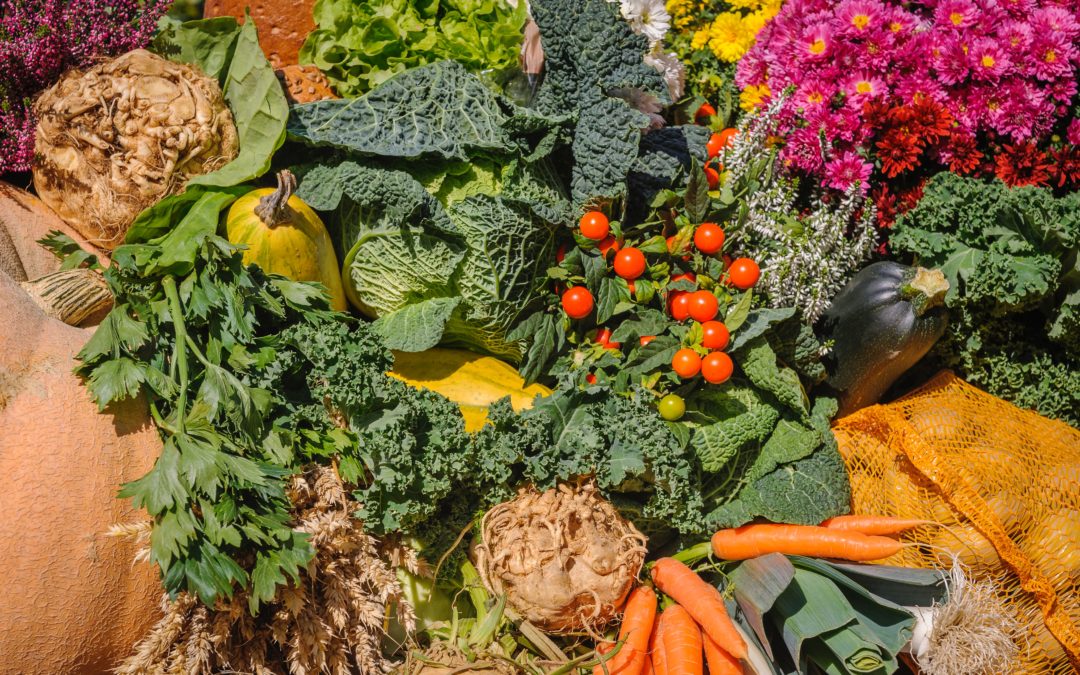The smell of tomatoes ripening on the vine, the sound of a hummingbird zooming past, and the sight of an early morning summer sky are just a few of the pleasures gardening offers. Add to that list the anti-inflammatory effects of fresh vegetables and the myriad health benefits that the act of gardening itself offers. A British review of available studies found that gardening has been shown to lower blood pressure, increase Vitamin D levels, build dexterity and strength, and lower your risk of dementia. Gardening has also been shown to reduce stress and anxiety. Although we are entering the autumnal phase of the year, it is not too late to plant some seeds! Quick growing vegetables like radishes, lettuce, and greens can still be planted right now. Whether your energy and space allows for a few pots on a window sill, a porch container garden, or a full garden plot, read below for six steps to help you get started with gardening this Fall!
- Pick your location. Before you get started with gardening, think about location! Plants need sunshine, nutrients, and water to grow. The first step towards having a Fall garden is to make sure your plants will be well situated to get the sun they need. Most vegetables like six to eight hours of direct sunlight per day. They will grow with less, just not as quickly. Pick the best spot available to you: a sunny window, a well-situated front porch, or an unshaded part of your yard. Fall marks the time when the sun is a smidgen lower in the sky every day, and our available daylight is decreasing, so think ahead to where the sunshine will land in October and November as you pick your spot.
- Select your method. Once you have decided on a location, select how you want to cultivate your plants. There are many ways to get started gardening. Pots, containers, and raised beds work really well—they also do not require as much preparation as converting lawn to garden soil. Containers come in a range of options such as terracotta pots, plastic pots, and fabric bags to name a few. Fabric bags in particular are a quick and affordable way to have either a raised bed or a porch garden. They come in many sizes and don’t need to be constructed before you fill them with dirt. Plants like fabric bags because they do not have rigid walls. This allows roots to grow both healthier and larger than they would in rigid containers. In this blog post local gardening store Fifth Season offers a breakdown of the merits of fabric bags and how they can support root growth. If you like the idea of building a raised bed but don’t know where to start, check out this fantastic ten minute tutorial from Welsh gardener and author Huw Richards. Huw specializes in raised bed gardening and shares a variety of resources to support you, from videos to books.
- Build your soil. To consistently grow healthy and productive plants, we need to pay attention to the dirt they grow in! Sandy or compacted soil makes it hard for plants to get the nutrients and minerals they need. The ideal gardening soil is dark brown, holds together when you squeeze it, and lets water drain through easily. This type of soil will naturally have both the structure and microbes that best support your plants. It is built by blending in a lot of organic matter over time. In other words, add compost! If you are starting from scratch, try buying garden soil and compost to blend into your chosen container or raised bed. If you already have a garden space, try top-dressing with about two inches of compost to enrich your existing garden soil before planting. You can source compost by the bag from local gardening stores or by the cubic yard from local businesses. Regardless of where you choose to buy compost, make sure it is for vegetable gardening. Compost intended for landscape design might not match the quality you would ideally like to grow food in! Making sure you have good soil will help you to get started gardening successfully.
- Think about timing. The first frost date of the year is a deadline of sorts. Ideally, you want any veggies you are growing to have had time to grow to maturity so that they are strong and resilient in the face of cold weather. The average first frost date for Asheville proper is around October 22. However, that date will vary depending on whether you live on top of a mountain or in a valley. Here is a website where you can enter your zip code to get a more accurate read of your zone: https://www.almanac.com/gardening/frostdates.
- Choose your plants. Right now is a good time to plant “starts”—young plants started from seed that you buy from a greenhouse or gardening center— or direct seed veggies that 1) grow quickly, 2) handle the cold really well, or 3) do both. On the back of most seed packets you will find a treasure trove of information: the number of days between planting the seed and being able to harvest, sunlight preference, how deep to plant the seed, and how far to space your seeds apart when planting. Below is a list of veggies that tend to grow quickly and/or are cold hardy, along with the number of days between planting the seed and being able to harvest for eating:
- Radishes: 20-60 days [spring versus winter time to harvest]
- Spinach: 37-45 days [cold hardy]
- Lettuce: 30-60 days, depending on the variety [will not handle cold well, but grows quickly]
- Kale: 70-80 days [cold hardy]
- Collards: 75-85 [cold hardy]
- Arugula:30-40 days [cold hardy]
- Mustard Greens: 30-50 days [cold hardy]
- Green Onion: 20-30 days [cold hardy]
- Salad Mix or Stir Fry Mix: 28 days [cold-sensitive, depending on varieties]
- Decide whether you want to extend your Fall garden into the Winter. This is an age-old practice that involves providing some degree of insulation to your vegetables, protecting them from frost damage. Parisian market gardeners in the 1800’s used bales of straw, glass, and specially manufactured jars to double or triple insulate their winter vegetables. By so doing, they provided fresh produce to Parisian markets year-round. For those of us in the Asheville area and the 21st century, there are “row covers”—specially made fabric designed to protect crops from frost. If this interests you, you can read through the different types of gardening fabric out there here.
As you head outside, don’t forget Janet Kilburn Phillips’s quote: “There are no gardening mistakes, only experiments.” In my personal garden, we focus on doing a little bit better each year and learning a lot along the way. First, get started gardening – no matter where you are beginning from. Enjoy the opportunities that gardening offers to nurture both plants and your well-being at the same time. If this is your first foray into growing food, start small! And know that whatever scale garden you choose to tend, it will offer benefits to your body, spirit, and mind.
Resources:
- The Buncombe County Master Gardener website has quite a few resources, videos, and tips to support your gardening.
- Huw Richard’s YouTube channel has many videos that break down how to get a garden started, and then many ways to learn, improve, and expand your garden over time.
- The Almanac’s website offers a great “Beginner’s Guide” with some additional information and tips to get you started.
- Charles Dowding offers a look at how he manages his market garden over the winter, including his row cover system.
Sources:
- https://www.bhg.com/gardening/vegetable/vegetables/planning-your-first-vegetable-garden/#:~:text=The%20fastest%2Dgrowing%20vegetables%20need,loving%20vegetables%20in%20shady%20spaces.
- https://www.psychologytoday.com/us/blog/hide-and-seek/201912/why-we-garden
- https://chatham.ces.ncsu.edu/2015/08/plant-a-fall-garden/
- Eliot Coleman’s The New Organic Grower, 3rd Edition: A Master’s Manual of Tools and Techniques for the Home and Market Gardener, 30th Anniversary Edition.
This blog post was written by our Integrative Health Coach, Ariana Figueroa, NBC-HWC. You can learn more about Ariana in her bio! To learn about how Integrative Family Medicine of Asheville does medicine differently, check out our website.

